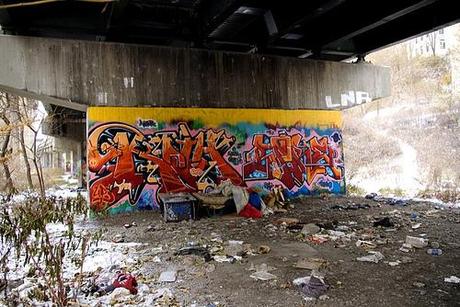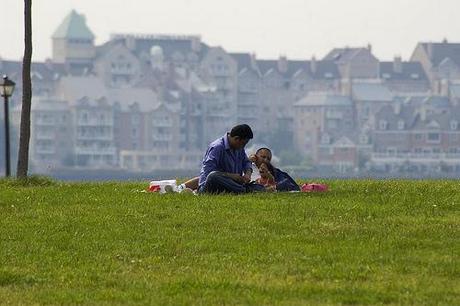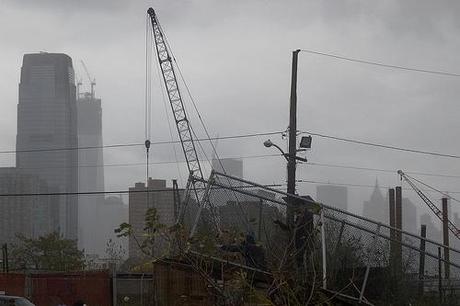* * * * *

I think of that as a Chamber of Commerce shot, or a postcard shot. It’s slick, bright, and cheery. But it’s also real. That’s the Jersey City that’s been getting all the attention, the Jersey City of Big Money high-rise buildings on the waterfront.
This is Jersey City from the other side:

When you drive into downtown Jersey City heading to New York City by way of the Holland Tunnel, that blither of signs is what greets and guides you. For tens and hundreds of thousands of commuters and travelers, that’s all there is to Jersey City.
And this Jersey City is hidden to most, but it’s near to my heart:

The graffiti is first class and, like almost all graffiti, it’s transient (as are we). Some homeless men got embroiled in a conflict several months later and set fire to one another’s stuff (see it there in front of the wall?). These pieces were badly burned and are now underneath several more layers of paint.
Look at the writing at the bottom of this flick:

Some letters are missing. The full name is Nacirma, the name of a New Jersey construction company. It’s also “America” spelled backwards. In 1956 Horace Miner published a very learned article, “Body Ritual Among the Nacirema” in a very learned journal, American Anthropologist. Some people got the joke, some didn’t.
But what’s that exotic foliage behind those buckets? Is that in Jersey City? Yes it is. There’s more of that kind of foliage in Liberty State Park, which also affords us unusual views of the Statue of Liberty:

If you look in a different direction, the city almost disappears:

But not completely. You can see hints of it in background at the middle of the photograph. At a different spot, from a different angle:

Behind us and a bit further south we can look across the green at Port Liberté:

At the north end of the park we have the remnants of the train shed for the Central Railroad of New Jersey, which brought passengers to the shore where they then took the ferry to Manhattan. Just beyond the shed, at the northern border of the park, you’ll see Liberty Marina:

That’s Lower Manhattan in the background, Jersey City’s hulking dinosaur of a neighbor to the East. All those windows were dark in the wake of hurricane Sandy.
Jersey City was knocked out as well:

The weather makes equals of us all. As does the graveyard:

That’s Harsimus Cove Cemetery, the oldest in the city. Look at the different styles of gravestones, and look at the variety of names.
Buildings die as well:

The foreground rubble used to be a railroad yard. The red brick building in the background to the right used to belong to the Seaboard Terminal and Refrigeration Company and was served by fright lines that no longer exist. It’s now used for specialty storage by Moishe’s Moving and Storage.
Finally, my neighborhood, Lafayette, one of the oldest in the city. That’s Webb park (used to be Lafayette Park, after the French general, aristocrat, and friend of the American Revolution):

The buildings in the background used to be Jersey City Medical Center, an art deco extravaganza built by Boss Hague. Now those buildings are being converted into luxury apartments.
That whale is also in Webb park:

The church behind it is Monumental Baptist Church.
And a couple of blocks away you can see this old 1948 Audi mounted in front of an auto-repair shot:

They do good work at a good price.
* * * * *
I selected these photos from this set of 140 photos. Those in turn came from the 1000s of photos in this collection.

